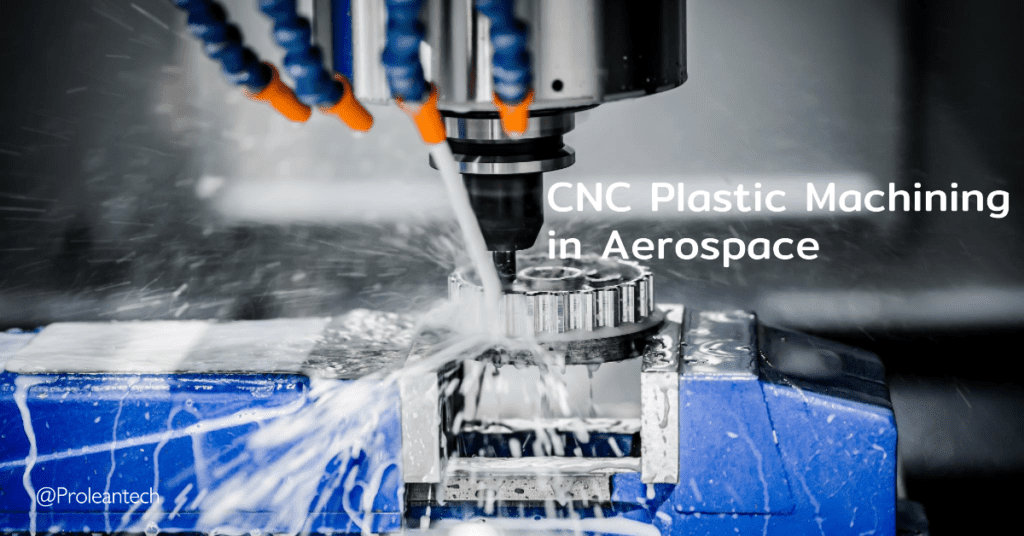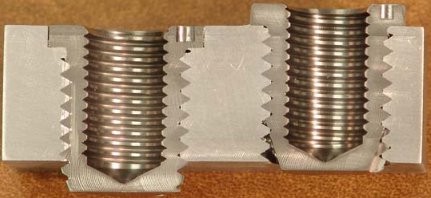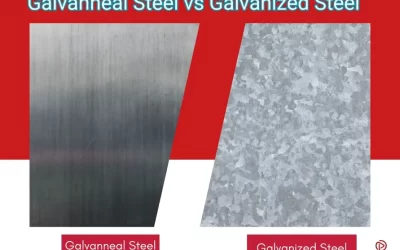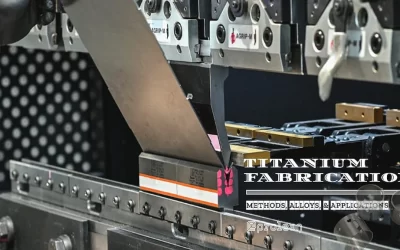
In the field of aerospace, the stakes are high, and the requirements for materials and manufacturing processes are stringent. Aircraft components must be lightweight, durable, heat-resistant, and capable of withstanding extreme conditions. Over the years, the aerospace industry has turned towards more innovative manufacturing methods to meet these demands, with Computer Numerical Control (CNC) plastic machining being one such method.
This article presents an in-depth case study of how CNC plastic machining, particularly Prolean’s services, has been instrumental in creating durable and lightweight components for the aerospace industry.
Why Use Plastic in the Aerospace Industry?

The aerospace industry is one that demands high performance in all of its components. Every part of an aircraft, from the smallest bolt to the largest wing, must meet exacting standards for weight, strength, and resistance to various forms of stress. While metals like aluminum and titanium have traditionally been used in aircraft construction due to their strength and lightness, plastics, especially high-performance plastics, are becoming increasingly popular.
High-performance plastics offer several advantages over traditional materials:
- Lightweight: Plastics are significantly lighter than most metals. This characteristic is crucial in aerospace, where every gram of weight can impact fuel efficiency and overall performance.
- Strength and Durability: Many high-performance plastics exhibit superior strength and durability, often matching or even surpassing that of their metal counterparts. They can withstand considerable mechanical stress, high temperatures, and corrosive chemicals, making them suitable for many aerospace applications.
- Resistance to Heat and Corrosion: Plastics are naturally resistant to corrosion, unlike many metals. Some high-performance plastics can also withstand high temperatures, which is essential in areas like engine nacelles and exhaust systems.
- Flexibility in Design: Plastics can be molded into complex shapes much more easily than metals, offering greater design flexibility. This capability is valuable in an industry where aerodynamics and space utilization are paramount.
- Cost-effectiveness: While high-performance plastics can be more expensive than standard plastics, they often prove more cost-effective than metals when considering the machining, finishing, and maintenance costs.
Here’s a table summarizing the benefits of using plastics in the aerospace industry:
| Properties | Benefits |
|---|---|
| Lightweight | Improved fuel efficiency and performance |
| Strength & Durability | Longevity and reliability |
| Heat & Corrosion Resistance | Suitability for a wide range of applications |
| Design Flexibility | Ability to create complex, aerodynamic shapes |
| Cost-effectiveness | Lower overall costs compared to metals |
The Role of CNC Plastic Machining in Aerospace
CNC plastic machining has become a critical tool in the aerospace industry, enabling the creation of precise, high-quality components from high-performance plastics.
In the aerospace industry, parts must be produced with extreme precision to ensure safety and performance. CNC machining provides the necessary precision and repeatability, with computer-controlled tools that can produce the same part consistently, even over large production runs.
CNC plastic machining is particularly useful for producing complex parts that would be difficult or impossible to create with traditional manufacturing methods. The ability to produce intricate shapes and features, including undercuts, threaded holes, and contoured surfaces, is invaluable in an industry that demands such complexity.

Some specific applications of CNC plastic machining in the aerospace industry include:
- Interior Components: From seating and overhead compartments to light covers and control knobs, many interior components of an aircraft are made from plastic. These parts must be lightweight, durable, and attractive, all qualities that can be achieved with CNC plastic machining.
- Insulation Elements: High-performance plastics are used for thermal and electrical insulation in various parts of an aircraft. CNC machining allows these elements to be created with precision, ensuring a perfect fit.
- Lightweight Structural Parts: Certain structural components, such as brackets and clamps, can be made from high-performance plastics to reduce weight without sacrificing strength.
Overall, CNC plastic machining plays a critical role in the aerospace industry, offering the precision, repeatability, and flexibility necessary to produce high-quality, high-performance components.
Case Study: Lighter and More Durable Aerospace Components with CNC Plastic Machining
As a concrete example of how CNC plastic machining is revolutionizing the aerospace industry, let’s consider the case of a leading aerospace manufacturer that decided to replace some of its metal components with plastic ones to achieve a lighter and more fuel-efficient design.
The aerospace manufacturer was producing a new line of commercial aircraft and wanted to reduce the weight of the aircraft to save on fuel costs. After comprehensive material testing and analysis, the team decided to replace certain non-critical metal components with high-performance plastic ones.
The chosen plastic was PEEK (Polyether Ether Ketone), a high-performance plastic known for its exceptional strength, heat resistance, and dimensional stability, making it an ideal substitute for metal in certain aerospace applications. However, the complex geometries of the parts posed a significant challenge.
The manufacturer partnered with Prolean’s CNC Machining Services to produce the new plastic components. Our skilled team programmed the CNC machines to carve the intricate shapes required out of blocks of PEEK with remarkable precision and consistency. The following benefits were observed:
- Weight Reduction: The new PEEK parts were considerably lighter than their metal counterparts, contributing to the overall weight reduction of the aircraft and leading to significant fuel savings.
- Increased Durability: The PEEK components proved to be more durable and required less maintenance than the metal parts they replaced, reducing the aircraft’s downtime and maintenance costs.
- Cost Savings: Although PEEK is a more expensive material than most metals, the cost savings achieved from reduced fuel consumption and maintenance far outweighed the higher material costs.
- Improved Performance: The lighter aircraft had better performance, including improved speed, range, and payload capacity.
This case study serves as a real-world example of the role CNC plastic machining plays in the aerospace industry, emphasizing how it contributes to the production of lighter, more durable, and more efficient aircraft.
Prolean’s CNC Machining Services: Your Partner for Aerospace Components
In the rapidly evolving aerospace industry, partnering with a trusted CNC machining service provider like Prolean can be a game-changer. Prolean offers state-of-the-art CNC plastic machining services that ensure the highest level of precision and quality.
Why choose Prolean’s CNC Machining Services for your aerospace needs?
| Key Features | Benefits |
|---|---|
| Expertise in High-Performance Plastics | Prolean has a deep understanding of high-performance plastics and their applications in the aerospace industry. Their team of experts can guide you in selecting the right material for your specific needs. |
| Advanced CNC Machining Capabilities | Prolean uses the latest CNC technology to deliver parts with tight tolerances and complex geometries. Whether you require a small prototype batch or large-scale production, Prolean can meet your needs. |
| Quality Assurance | Prolean has rigorous quality control processes in place to ensure that every part meets the highest standards. You can rest assured that your components will be produced accurately and consistently. |
| Turnkey Solutions | Prolean offers end-to-end solutions, from material selection and design assistance to production, finishing, and assembly. |
| Exceptional Customer Service | Prolean is committed to providing exceptional customer service, working closely with you at every stage of your project to ensure your complete satisfaction. |
The Future of CNC Plastic Machining in Aerospace
As the aerospace industry continues to seek ways to increase performance and fuel efficiency, the use of high-performance plastics and CNC plastic machining is set to grow. Here’s a glimpse at what the future might hold:
- Greater Use of High-Performance Plastics: More aerospace components are likely to be made from high-performance plastics as their properties continue to improve and as new materials are developed.
- Increased Precision and Complexity: As CNC machining technology advances, we can expect even higher levels of precision and the ability to produce increasingly complex geometries.
- Integration with Other Technologies: CNC plastic machining may be used in conjunction with other technologies such as additive manufacturing (3D printing) to create hybrid components that take advantage of the best properties of each technology.
- Sustainability: The aerospace industry is under pressure to become more sustainable. Using high-performance plastics that are lighter and last longer can help reduce the industry’s carbon footprint.
Conclusion
The case study presented in this article shows the pivotal role that CNC plastic machining plays in the aerospace industry. By replacing certain metal components with high-performance plastic ones, aerospace manufacturers can achieve significant weight reduction, improve durability, and realize cost savings. Prolean’s CNC Machining Services, with its state-of-the-art technology and expertise in high-performance plastics, can help manufacturers navigate this transition and prepare for a future where the use of plastics in aerospace is likely to increase.
FAQs
Why is weight reduction important in the aerospace industry?
Weight reduction is crucial in the aerospace industry because lighter aircraft use less fuel, which not only reduces operating costs but also lessens the environmental impact.
Are plastic components as durable as metal ones in aerospace applications?
High-performance plastics like PEEK can be as durable, or even more durable, than some metals in certain applications. They are resistant to wear, heat, and chemicals, which makes them ideal for many aerospace applications.
Can CNC plastic machining handle complex part geometries?
Yes, CNC plastic machining can handle highly complex part geometries. This is one of the reasons why it’s ideal for producing intricate aerospace components.
How do Prolean’s CNC Machining Services contribute to the aerospace industry?
Prolean offers precision CNC plastic machining services, allowing aerospace manufacturers to produce lightweight, durable components. Their deep understanding of high-performance plastics, state-of-the-art CNC technology, and rigorous quality control processes ensure that every part meets the highest standards.
What does the future hold for CNC plastic machining in the aerospace industry?
The use of CNC plastic machining in aerospace is set to increase as the industry continues to seek ways to improve performance and fuel efficiency. The technology will evolve to offer even greater precision and the ability to handle more complex geometries.




0 Comments